Earth:Nemegt Formation
| Nemegt Formation Stratigraphic range: Maastrichtian ~70 Ma | |
|---|---|
 Nemegt, the type locality of the Nemegt Formation | |
| Type | Geological formation |
| Sub-units | Lower, Middle and Upper units |
| Underlies | Alluvium |
| Overlies | Barun Goyot Formation |
| Thickness | Over 235 m (771 ft) |
| Lithology | |
| Primary | Shale, sandstone |
| Other | Mudstone, conglomerate |
| Location | |
| Coordinates | [ ⚑ ] : 43°30′N 101°00′E / 43.5°N 101.0°E |
| Paleocoordinates | [ ⚑ ] 40°48′N 90°12′E / 40.8°N 90.2°E |
| Region | Bayankhongor Aimag, Omnogov, Ovorkhangai |
| Country | |
| Extent | Gobi Desert |
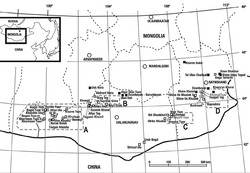 Cretaceous-aged dinosaur fossil localities of Mongolia. Nemegt localities at area A. | |
The Nemegt Formation (also known as Nemegtskaya Svita) is a geological formation in the Gobi Desert of Mongolia, dating to the Late Cretaceous. The formation consists of river channel sediments and contains fossils of fish, turtles, crocodilians, and a diverse fauna of dinosaurs, including birds.
Description
The Nemegt Formation is composed of mudstones and sandstones that were deposited by ancient lakes, streams, and flood plains. The Altan Uul locality was described by Michael Novacek as "a canyon carved out of a very rich series of sedimentary rocks" with "steep cliffs and narrow washes". The climate associated with it was wetter than when preceding formations were deposited; there seems to have existed at least some degree of forest cover. Fossilized trunks have been also found. These petrified wood, and the remains of Araucariaceae conifers indicate that the forests of the Nemegt were thickly wooded, with a high canopy formed by tall conifer trees. When examined, the rock facies of this formation suggest the presence of stream and river channels, mudflats, and shallow lakes. Sediments also indicate that there existed a rich habitat, offering diverse food in abundant amounts that could sustain massive Cretaceous dinosaurs.[1][2]
Stratigraphy
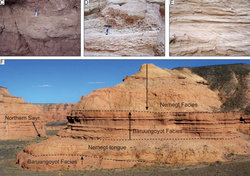
The most recent stratigraphy divides the Nemegt Formation into three informal members. The lower member is dominated by fluvial deposits, while middle and upper members consist of alluvial plain, paludal, lacustrine, and fluvial deposits. The colour of the sediments is usually light grey to tan in colour in comparison to the typically red colour of the underlying Barun Goyot Formation.[3] It overlies and sometimes interfingers with the Barun Goyot Formation. Interfingering has been noted at the stratotype (Red Walls) and Hermiin Tsav.[3] There has been no absolute dating of the Nemegt Formation. Historically the Nemegt has been considered late Campanian to Maastrichtian, based on comparisons of fossils present, but no exact dating has been performed. The age for the underlying Baruungoyot Formation (= Svita) has been suggested as Santonian to Campanian, and Shuvalov (2000) found K-Ar dating of basalts that they referred to the mid and upper Baruungoyot to be 75 to 80 million years old.[4]
Paleobiota of the Nemegt Formation
Stratigraphic positions are based on Eberth (2018) who correlated localities to their approximate position within the formation.[3]Template:Paleobiota-key-compact
Amphibians
| Genus | Species | Location | Stratigraphic position | Material | Notes | Image |
|---|---|---|---|---|---|---|
| Altanulia | A. alifanovi | Altan Uul II | Middle or Upper | "Partial maxilla."[5] | A discoglossid. Its classification has been criticized.[6] |
Crocodylomorphs
| Genus | Species | Location | Stratigraphic position | Material | Notes | Image |
|---|---|---|---|---|---|---|
| Paralligator[7] | P. gradilifrons[7] | Nemegt, Nogon Tsav, Ulaan Bulag | Lower | "Partially complete skulls with sparse body elements."[7] | A paralligatorid. | 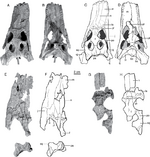
|
Fish
| Genus | Species | Location | Stratigraphic position | Material | Notes | Image |
|---|---|---|---|---|---|---|
| Harenaichthys | H. lui | Altan Uul, Bügiin Tsav, Hermiin Tsav, Ulan Khushu | "Partial skull parts, isolated and articulated centra, and articulated caudal fin."[8] | An osteoglossomorph. Includes previously reported material.[9][8] | ||
| Hiodontidae indet. | Indeterminate | Ulan Khushu | "Partial vertebrae and premaxilla."[9] | A mooneye. | ||
| Teleostei indet. | Indeterminate | Not specified. | "Vertebral centra found within a specimen of Raptorex."[9] | A teleost. | ||
| Osteichthyes indet. | Indeterminate | Bügiin Tsav | "Vertebrae and scales found within a specimen of Deinocheirus''."[10] | A bony fish. |
Flora
| Genus | Species | Location | Stratigraphic position | Material | Notes | Image |
|---|---|---|---|---|---|---|
| Araucariaceae indet. | Indeterminate | Altan Uul II, Nemegt | "Petrified wood and trunks."[11][2] | An araucarian. | ||
| Monilitheca | M. minuta | Ulaan Bulag | "Two isolated megasporophylls and megaspore casts."[12] | A sporophyll related to quillworts. | ||
| Lemnaceae indet. | Indeterminate | Tsagan Khushu, Ulaan Bulag | "Fruits."[13] | Duckweed. | ||
| Potamogeton-like indet. | Indeterminate | Ulaan Bulag | "Shoots and leaves."[13] | Pondweed. |
Invertebrates
| Genus | Species | Location | Stratigraphic position | Material | Notes | Image |
|---|---|---|---|---|---|---|
| Altanicypris | A. bispinifera | Altan Uul IV, Nemegt | Lower | "Complete carapace and left valve."[14] | An ostracod. | |
| A. multispina | Altan Uul IV, Nemegt | Lower | "Nine carapaces and some detached valves."[14] | An ostracod. | ||
| A. szczechurae | Altan Uul IV, Nemegt | Lower | "Multiple carapaces and detached valves."[14] | An ostracod. | ||
| Candona | C. altanulaensis | Altan Uul IV, Bügiin Tsav, Nemegt | "Multiple specimens with carapaces and valves."[14] | An ostracod. | ||
| cf. C. fabaeformis | Altan Uul IV, Nemegt | Lower | "Several carapaces and detached valves."[14] | An ostracod. | ||
| Candoniella | C. altanica | Altan Uul IV, Bügiin Tsav, Nemegt | "Multiple specimens with carapaces and valves."[14] | An ostracod. | ||
| C. mordvilkoi | Altan Uul IV | Lower | "Three adult carapaces."[15] | An ostracod. | ||
| Cyclocypris | C. transitoria | Bügiin Tsav, Nemegt | "Seven adult carapaces."[14] | An ostracod. | ||
| Cypria | C. elata | Bügiin Tsav, Hermiin Tsav | "Several carapaces and valves."[14] | An ostracod. | ||
| Cypridopsis? | C. bugintsavicus | Altan Uul IV, Bügiin Tsav, Nemegt, Tsagan Khushu | "Ten adult carapaces."[14] | An ostracod. | ||
| Indeterminate | Nemegt | Lower | "Several complete carapaces."[14] | An ostracod. | ||
| Cypris? | C. ectypa | Altan Uul IV, Bügiin Tsav, Nemegt, Ulan Bulag | "Complete carapaces and some detached valves."[14] | An ostracod. | ||
| Cypridea | cf. C. punctilataeformis | Nemegt | "One adult carapace."[15] | An ostracod. | ||
| C. barsboldi | Altan Uul IV, Bügiin Tsav, Nemegt | "Multiple specimens with carapaces and valves."[14] | An ostracod. | |||
| C. cavernosa | Altan Uul IV, Bügiin Tsav, Nemegt, Nogon Tsav | "Multiple specimens with carapaces and valves."[14] | An ostracod. | |||
| C. rostrata | Bügiin Tsav, Nemegt, Nogon Tsav | "Caparaces."[15] | An ostracod. | |||
| Indeterminate | Altan Uul IV, Nemegt | Lower | "Five juvenile carapaces."[14] | An ostracod. | ||
| Gobiella | G. prima | Altan Uul IV, Nemegt | Lower | "Several carapaces and detached valves."[14] | An ostracod. | |
| Khandia | K. stankevitchae | Altan Uul IV, Nemegt | Lower | "Multiple carapaces and valves."[14] | An ostracod. | |
| Leiria | Indeterminate | Nemegt | Lower | "Several detached valves."[14] | An ostracod. | |
| Indeterminate | Nemegt | Lower | "Complete carapace."[14] | An ostracod. | ||
| Limnocythere sp. | Indeterminate | Nemegt | Lower | "Juvenile carapace."[14] | An ostracod. | |
| Lycopterocypris? | cf. L. profunda | Altan Uul IV, Nemegt | Lower | "Multiple complete carapaces and left valve."[14] | An ostracod. | |
| Mongolianella | M. palmosa? | Altan Uul IV, Bügiin Tsav, Nemegt | "Several adult carapaces."[14] | An ostracod. | ||
| Mongolocypris | M. distributa | Altan Uul IV, Bügiin Tsav, Nemegt, Tsagan Khushu | "Multiple specimens with complete carapaces and valves."[14] | An ostracod. | ||
| Nemegtia | N. biformata | Altan Uul IV, Bügiin Tsav, Nemegt, Tsagan Khushu | "Multiple complete carapaces and several detached valves."[14] | An ostracod. | ||
| N. obliquecostae | Altan Uul IV, Nemegt | Lower | "Multiple carapaces and valves."[14] | An ostracod. | ||
| N. reticulata | Altan Uul IV, Bügiin Tsav, Nemegt, Nogon Tsav, Tsagan Khushu | "Several carapaces and detached valves."[14] | An ostracod. | |||
| Paracypridea? | P. mongolica | Altan Uul IV, Nemegt | Lower | "Multiple carapaces and detached valves."[14] | An ostracod. | |
| Rhinocypris sp. | Indeterminate | Nemegt | Lower | "Several carapaces."[14] | An ostracod. | |
| Scabriculocypris | S. ingenicus? | Altan Uul IV, Bügiin Tsav, Naran Bulag, Nemegt, Tsagan Khushu | "Multiple carapaces and valves."[14] | An ostracod. | ||
| S. rasilis? | Altan Uul IV, Nemegt | Lower | "Several carapaces and detached valves."[14] | An ostracod. | ||
| Timiriasevia | cf. T. miaogouensis | Altan Uul IV, Nemegt | Lower | "Seven valves."[14] | An ostracod. | |
| cf. T. opinabilis | Altan Uul IV | Lower | "Adult carapace."[15] | An ostracod. | ||
| T. minuscula | Altan Uul IV, Bügiin Tsav, Nemegt | "Multiple specimens with carapaces and valves."[14] | An ostracod. | |||
| T. naranbulakensis | Altan Uul IV, Bügiin Tsav, Nemegt | "Four carapaces and one right valve."[14] | An ostracod. | |||
| Ziziphocypris | Z. costata | Altan Uul IV, Bügiin Tsav, Nemegt | "Fourteen carapaces."[14] | An ostracod. |
Mammals
| Genus | Species | Location | Stratigraphic position | Material | Notes | Image |
|---|---|---|---|---|---|---|
| Buginbaatar[16] | B. transaltaiensis[16] | Bügiin Tsav | Middle or Upper | "Fragmentary skull."[16] | A multituberculate. | |
| "Gurlin Tsav skull" | Indeterminate | Middle or | Partial skull | A mysterious metatherian, possibly a sparassodont. |
Pterosaurs
| Genus | Species | Location | Stratigraphic position | Material | Notes | Image |
|---|---|---|---|---|---|---|
| Unnamed azhdarchid | Indeterminate | Guriliin Tsav | Middle or Upper | "Fragmentary cervical vertebrae."[17] | A giant azhdarchid. | 
|
Turtles
| Genus | Species | Location | Stratigraphic position | Material | Notes | Image |
|---|---|---|---|---|---|---|
| Gobiapalone | G. breviplastra | Alak Shand Khuduk, Altan Uul I, Bügiin Tsav, Bügiin Tsav II, Nemegt, Ulan Khushu | "Shell and body elements from multiple specimens."[18] | A trionychid. | ||
| Gravemys | G. barsboldi | Bamba Khuduk, Hermiin Tsav, Ingeni Khobur, Tsagan Khushu | "Partial to complete shells."[19][20] | A lindholmemydid. | ||
|
Nanhsiungchelyidae indet. |
Indeterminate | Hermiin Tsav II | Lower | "Shell fragment."[21] | A nanhsiungchelyid. | |
| Indeterminate | Khuren Tsav | "Damaged shell."[21] | A nanhsiungchelyid. | |||
| Indeterminate | Nemegt | Lower | "Partial plastron."[21] | A nanhsiungchelyid. | ||
| Mongolemys | M. elegans | Bügiin Tsav, Hermiin Tsav, Tsagan Khushu | "Skull, shell and body elements from multiple specimens."[22][23] | A lindholmemydid. | 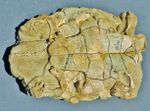
| |
| Mongolochelys | M. efremovi | Altan Uul II, Altan Uul III, Bügiin Tsav, Guriliin Tsav, Hermiin Tsav, Nemegt, Tsagan Khushu | "Skull, shell and body elements from multiple specimens."[24][25] | A sichuanchelyid. | ||
| Nemegtemys | N. conflata | Bügiin Tsav, Nemegt | "Partial plastron elements."[18] | A trionychid. | ||
|
"Trionyx" |
"T". gilbentuensis | Gilbentu | "Fragmentary shell."[18] | A trionychid. | ||
| "T". gobiensis | Altan Uul III, Bamba Khuduk, Nemegt, Tsagan Khushu | "Fragmentary shell and carapace fragments."[18] | A trionychid. | |||
| Trionychidae indet. | Indeterminate | Bamba Khuduk, Bügiin Tsav, Guriliin Tsav, Ingeni Khobur | "Shell and body remains."[18] | A trionychid. Originally identified as Amyda menneri.[18] |
Dinosaurs
Ankylosaurs
| Genus | Species | Location | Stratigraphic position | Material | Notes | Image |
|---|---|---|---|---|---|---|
| "Dyoplosaurus"[26] | "D". giganteus[26] | Nemegt | Lower | A series of caudal vertebrae, metatarsals, phalanges, osteoderms, and an undescribed partial tail club.[27] | An ankylosaurid now regarded as nomen dubium. | 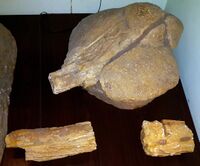
|
| Saichania[28] | S. chulsanensis[28] | Altan Uul IV | Lower | Partial vertebrae, tail club, and osteoderms.[29] | An ankylosaurid also present in the Barun Goyot Formation. | 
|
| Tarchia[28] | T. teresae[29] | Altan Uul IV, Hermiin Tsav I | Lower | A skull, mandibles, vertebrae, tail club, and other undescribed postcranial material.[29] | An ankylosaurid. | 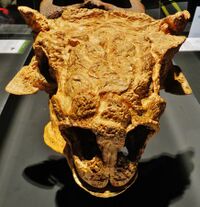
|
| T. tumanovae[30] | Hermiin Tsav | Lower[3] | "Partial skeleton with complete skull."[30] | An ankylosaurid. | 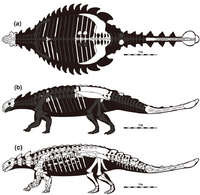
| |
| Tetrapodosaurus-like indet. | Indeterminate | Bügiin Tsav, Shar Tsav | "Footprint casts."[31] | Ankylosaurid tracks. | ||
| Ankylosauridae indet. | Indeterminate | Altan Uul II-III-IV, Bügiin Tsav, Hermiin Tsav I, Khuree Tsav, Nemegt | A partial dentary, caudal vertebrae, dorsal vertebrae, metatarsals, phalanges, pedal phalanx, humeri, partial pelvis, tail clubs, cervical half-rings, osteoderms, skin impressions, and undescribed of juveniles and partial skeletons.[27] | Cranial and postcranial material representing numerous individuals of different ages. | 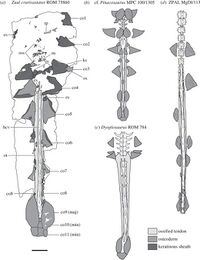
|
Alvarezsaurs
| Genus | Species | Location | Stratigraphic position | Material | Notes | Image |
|---|---|---|---|---|---|---|
| Mononykus[32] | M. olecranus[32] | Bügiin Tsav | Middle or Upper | "Fragmentary skull, vertebrae, limbs and fragmented pelvis."[33] | An alvarezsaurid. | 
|
| Mononykus cf. | Indeterminate | Altan Uul III | "Caudal vertebrae and left hindlimb."[34] | An alvarezsaurid. | ||
| Nemegtonykus[34] | N. citus[34] | Altan Uul III | "Partially complete skeleton from two specimens lacking the skull."[34] | An alvarezsaurid. |
Birds
| Genus | Species | Location | Stratigraphic position | Material | Notes | Image |
|---|---|---|---|---|---|---|
| Brodavis[35] | B. mongoliensis[35] | Bügiin Tsav | "Nearly complete left tarsometatarsus."[35] | A hesperornithine. | ||
| Gurilynia[36] | G. nessovi[36] | Guriliin Tsav | Middle or Upper | "Left coracoid and partial humerii."[36] | An enantiornithine. | |
| Judinornis[37] | J. nogontsavensis[37] | Nogon Tsav | "Dorsal vertebra."[37] | A hesperornithine. | ||
| Laevisoolithus[38] | L. sochavai | "Whole egg with partly broken pole"[38] | Laid by a bird or small theropod.[38] | |||
| Subtiliolithus[38] | S. microtuberculatus[38] | "Eggshell fragments"[38] | ||||
| Teviornis[39] | T. gobiensis[39] | Guriliin Tsav | Middle or Upper | "Partial forelimbs."[39] | An anseriform. | |
| Unnamed ornithurans | Indeterminate | Tsagan Khushu | "A humerus and two tibiotarsi."[40] | Ornithuran remains. |
Dromaeosaurs
| Genus | Species | Location | Stratigraphic position | Material | Notes | Image |
|---|---|---|---|---|---|---|
| A. mongoliensis[41] | Bügiin Tsav | Middle or Upper | "Partial skull and fragmentary postcrania from two specimens."[42] | A dromaeosaurid. | 
| |
|
Dromaeosauridae indet. |
Indeterminate | Bügiin Tsav | Middle or Upper | "Cervical vertebra."[43] | A dromaeosaurid. | |
| Indeterminate | Hermiin Tsav | Lower | "Dorsal vertebra."[44] | A dromaeosaurid. | ||
| Indeterminate | Khaichin I | "Three teeth."[45] | A dromaeosaurid. | |||
| Indeterminate | Nemegt | Lower | "Dorsal vertebra and other elements."[44][46] | A dromaeosaurid. | ||
| Indeterminate | Indeterminate | Bügiin Tsav | "Footprints with poor claw marks."[47] | Two-toed theropod tracks. Attributed to either Adasaurus or Zanabazar. |
Hadrosaurs
| Genus | Species | Location | Stratigraphic position | Material | Notes | Image |
|---|---|---|---|---|---|---|
| Amblydactylus-like indet. | Indeterminate | Bügiin Tsav, Bügiin Tsav II, Guriliin Tsav, Yagaan Khovil | "Footprint casts."[31] | Three-toed hadrosaurs tracks. Attributed to Saurolophus. | ||
| Barsboldia[48] | B. sicinskii[48] | Nemegt | Lower[3] | "Partial vertebrae, pelvis, and ribs."[48][49] | A hadrosaurid. | 
|
| Hadropodus | Indeterminate | Nemegt | "Numerous footprints."[50] | Hadrosaurid tracks. Attributed to Saurolophus. | ||
| Saurolophus[51] | S. angustirostris[52] | Presence in most localities[53] | "Multiple specimens, including articulated skulls, postcranial skeletons and mass death assemblage."[54][55][56][57] | A saurolophine hadrosaurid which was the most common hadrosaur in the area.[58] | 
| |
| Unnamed ichnotaxon | Indeterminate | Nemegt | "Numerous footprint casts with trackways."[59] | Hand and feet hadrosaur tracks. Attributed to Saurolophus. |
Ornithomimosaurs
| Genus | Species | Location | Stratigraphic position | Material | Notes | Image |
|---|---|---|---|---|---|---|
| Anserimimus[60] | A. planinychus[60] | Bügiin Tsav | Middle or Upper[3] | "Partial skeleton lacking the skull."[60][61] | An ornithomimid. | 
|
| Deinocheirus[62] | D. mirificus[62] | Altan Uul III-IV, Bügiin Tsav |
|
"Complete skull with virtually complete postcranial remains from three specimens."[10] | A giant deinocheirid. | 
|
| Gallimimus[63] | G. bullatus[63] | Presence in most localities[64] | "Multiple specimens with nearly complete skull and postcranial elements."[64][65] | An ornithomimid. | 
| |
| Indeterminate | Indeterminate | Bügiin Tsav | "Nine trackways including an articulated Gallimimus foot."[47] | Three-toed theropod tracks. Attributed to ornithomimids. | ||
| Unnamed ornithomimid[66] | Indeterminate | Tsagan Khushu | "Partial vertebral column with fore and hindlimbs."[66][64] | An ornithomimid. |
Oviraptorosaurs
| Genus | Species | Location | Stratigraphic position | Material | Notes | Image |
|---|---|---|---|---|---|---|
| Avimimus[67] | A. portentosus[67] | Shar Tsav | "Skull roof with fragmentary body elements."[68] | An avimimid. Also present in the Djadokhta Formation. | 
| |
| A. nemegtensis[68] | Nemegt | Lower[3] | "Fragmented skull with partial skeleton."[68] | An avimimid. | 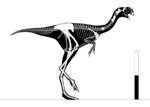
| |
| Conchoraptor | C. gracilis | Guriliin Tsav | Middle or Upper | "Skull and a flock of articulated individuals."[69] | An oviraptorid. Also present in the Barun Goyot Formation. | 
|
| Elmisaurus[70] | E. rarus[70] | Altan Uul II, Nemegt |
|
"Fragmentary skull and partially skeletons from several specimens."[68][71] | A caenagnathid. | 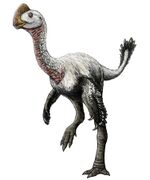
|
| Elongatoolithidae indet. | Indeterminate | Bügiin Tsav | "Three eggs containing embryonic remains."[72] | Oviraptorid eggs. | ||
| Gobiraptor[73] | G. minutus[73] | Altan Uul III | "Partial crania with complete lower jaws and fragmented postcrania."[73] | An oviraptorid. | ||
| Indeterminate | Indeterminate | Hermiin Tsav, Shar Tsav, Yagaan Khovil | "Footprint casts."[31] | Three-toed theropod tracks. Attributed to Avimimus. | ||
| Nemegtomaia[74] | N. barsboldi[74] | Nemegt | Lower | "Multiple specimens including a nesting specimen and eggs."[75] | An oviraptorid also present in the Barun Goyot Formation. | 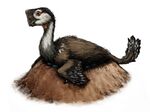
|
| Nomingia[76] | N. gobiensis[76] | Bügiin Tsav, Nemegt |
|
"Vertebral series with partial hindlimbs and a referred pygostyle."[68] | A caenagnathid. May be synonymous with Elmisaurus.[71] | 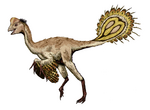
|
| Oksoko[77] | O. avarsan | Bügiin Tsav, Guriliin Tsav | Middle or Upper | "Multiple associated skeletons."[77] | An oviraptorid. | 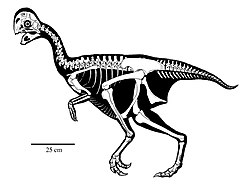
|
| Rinchenia[78] | R. mongoliensis[78] | Altan Uul II | Middle or Upper | "Skull with nearly complete skeleton."[68] | An oviraptorid. | 
|
Pachycephalosaurs
| Genus | Species | Location | Stratigraphic position | Material | Notes | Image |
|---|---|---|---|---|---|---|
| Homalocephale[79] | H. calathocercos[79] | Nemegt | Lower[3] | "Partial skull and skeleton including hindlimbs."[79] | A pachycephalosaurid. | 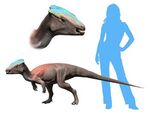
|
| Prenocephale[79] | P. prenes[79] | Guriliin Tsav, Nemegt |
|
"Complete skull and partial postcranium of several specimens."[79][80] | A pachycephalosaurid. | 
|
| P. sp.[80] | Tsagan Khushu, Nemegt | Lower[3] | "complete left squamosal"; large skull | |||
| Indeterminate | Bugiin Tsav | Middle or Upper[3] | "incomplete frontoparietal dome and fragments of associated braincase bones"[80] |
Sauropods
| Genus | Species | Location | Stratigraphic position | Material | Notes | Image |
|---|---|---|---|---|---|---|
| Brontopodus | Indeterminate | Nemegt | Lower | "Large footprint and several four-toed tracks."[81][50] | Sauropod tracks. Attributed to Opisthocoelicaudia. | |
| Brontopodus-like indet. | Indeterminate | Bügiin Tsav, Yagaan Khovil | "Footprint casts."[31] | Sauropod tracks. | ||
| Nemegtosaurus[82] | N. mongoliensis[82] | Nemegt | Lower | "Skulls and body remains from several specimens."[83][84][85] | A titanosaur. | 
|
| Opisthocoelicaudia[86] | O. skarzynskii[86] | Altan Uul IV | Lower | "Nearly complete skeleton without the skull and cervical series."[84] | A titanosaur. | 
|
| Undescribed sauropods | Indeterminate | Altan Uul I-II-II-IV, Bügiin Tsav, Guriliin Tsav, Hermiin Tsav, Khamaryn Khural, Khuree Tsav, Nemegt, Nogon Tsav, Tsagan Khushu, Ulan Khushu | "Several fragmentary remains."[84] | Sauropod remains that may represent already named taxa. | ||
| Unnamed ichnotaxon | Indeterminate | Nemegt | "Footprint casts with skin impressions."[59] | Four-toed sauropod tracks. Attributed to Opisthocoelicaudia. |
Therizinosaurs
| Genus | Species | Location | Stratigraphic position | Material | Notes | Image |
|---|---|---|---|---|---|---|
| Therizinosaurus[87] | T. cheloniformis[87] | Hermiin Tsav, Nemegt | Lower[3] | "Fore and hindlimb elements from multiple specimens."[88][89] | A giant therizinosaurid. | 
|
| Undescribed therizinosaurids | Indeterminate | Altan Uul, Bügiin Tsav, Guriliin Tsav, Ulan Khushu | "Partial remains."[90] | Therizinosaurid remains. |
Troodontids
| Genus | Species | Location | Stratigraphic position | Material | Notes | Image |
|---|---|---|---|---|---|---|
| Borogovia[91] | B. gracilicrus[91] | Altan Uul IV | Lower | "Partial hindlimbs."[91] | A troodontid. | |
| Indeterminate | Indeterminate | Bügiin Tsav | "Footprints with poor claw marks."[47] | Two-toed theropod tracks. Attributed to either Adasaurus or Zanabazar. | ||
| Tochisaurus[92] | T. nemegtensis[92] | Nemegt | Lower | "Left metatarsus."[92] | A troodontid. | |
| Zanabazar[93] | Z. junior[94] | Bügiin Tsav | Middle or Upper | "Skull with fragmentary postcranial skeleton."[93] | A troodontid originally identified as "Saurornithoides junior". | 
|
Tyrannosaurs
| Genus | Species | Location | Stratigraphic position | Material | Notes | Image |
|---|---|---|---|---|---|---|
| Alioramus[95] | A. remotus[95] | Nogon Tsav | "Partially preserved skull with very sparse postcranial remains."[95] | An alioramin. | 
| |
| A. altai[96] | Tsagan Khushu | "Nearly complete skull with partial postcrania."[96] | An alioramin. | 
| ||
| Bagaraatan[97] | B. ostromi[97] | Nemegt | Lower[3] | "Fragmentary lower jaw, hindlimb and caudal vertebrae."[97] | A tyrannosauroid. | |
| Indeterminate | Indeterminate | Bügiin Tsav, Bügiin Tsav II | "Footprint casts."[31] | Three-toed theropod tracks. Attributed to Tarbosaurus. | ||
|
R. kriegsteni[98] |
"Nearly complete skeleton including the skull."[98] | A controversial genus of tyrannosaurid that could be a juvenile Tarbosaurus.[99] | 
| |||
| Tarbosaurus[100] | T. bataar[101] | Presence in most localities[2] | "Nearly complete skeletons from multiple specimens."[100][101][2] | A large tyrannosaurid which was the most common large carnivore in the area.[102] | 
| |
| Unnamed ichnotaxon | Indeterminate | Nemegt | "Footprint casts with skin impressions."[59] | Three-toed theropod tracks. Attributed to Tarbosaurus. | ||
| Tyrannosauripodidae indet. | Indeterminate | Nemegt | "Five tracks."[50] | Three-toed tyrannosaurid tracks. Attributed to either Alioramus or Tarbosaurus. |
See also
- Djadochta Formation
- List of dinosaur-bearing rock formations
- List of fossil sites
- Nemegt Basin
References
- ↑ Novacek, M. (1996). Dinosaurs of the Flaming Cliffs. Bantam Doubleday Dell Publishing Group Inc. New York, New York. ISBN:978-0-385-47775-8
- ↑ 2.0 2.1 2.2 2.3 Owocki, K.; Kremer, B.; Cotte, M.; Bocherens, H. (2020). "Diet preferences and climate inferred from oxygen and carbon isotopes of tooth enamel of Tarbosaurus bataar (Nemegt Formation, Upper Cretaceous, Mongolia)". Palaeogeography, Palaeoclimatology, Palaeoecology 537: 109190. doi:10.1016/j.palaeo.2019.05.012. Bibcode: 2020PPP...53709190O.
- ↑ 3.00 3.01 3.02 3.03 3.04 3.05 3.06 3.07 3.08 3.09 3.10 3.11 3.12 3.13 Eberth, David A. (1 April 2018). "Stratigraphy and paleoenvironmental evolution of the dinosaur-rich Baruungoyot-Nemegt succession (Upper Cretaceous), Nemegt Basin, southern Mongolia" (in en). Palaeogeography, Palaeoclimatology, Palaeoecology 494: 29–50. doi:10.1016/j.palaeo.2017.11.018. Bibcode: 2018PPP...494...29E. https://linkinghub.elsevier.com/retrieve/pii/S0031018217305771.
- ↑ Shuvalov, V.F. (2000). "The Cretaceous stratigraphy and palaeobiogeography of Mongolia". in Benton, Michael J.; Shishkin, Mikhail A.; Unwin, D.M. et al.. The Age of Dinosaurs in Russia and Mongolia. Cambridge University Press. pp. 256–278. ISBN 0-521-55476-4. https://archive.org/details/agedinosaursruss00bent.
- ↑ Gubin, Y. M. (1993). "Cretaceous anurans of Mongolia" (in ru). Paleontological Journal: 51−56.
- ↑ Sanchíz, B. (1998). "Salientia Part 4". Handbuch der Paläoherpetologie. Munich. pp. 1−275.
- ↑ 7.0 7.1 7.2 Turner, A. H. (2015). "A Review of Shamosuchus and Paralligator (Crocodyliformes, Neosuchia) from the Cretaceous of Asia". PLOS ONE 10 (2): e0118116. doi:10.1371/journal.pone.0118116. PMID 25714338. Bibcode: 2015PLoSO..1018116T.
- ↑ 8.0 8.1 Kim, S.-H.; Lee, Y.-N.; Park, J.-Y.; Lee, S.; Winkler, D. A.; Jacobs, L. L.; Barsbold, R. (2022). "A new species of Osteoglossomorpha (Actinopterygii: Teleostei) from the Upper Cretaceous Nemegt Formation of Mongolia: Paleobiological and paleobiogeographic implications". Cretaceous Research 135: 105214. doi:10.1016/j.cretres.2022.105214. Bibcode: 2022CrRes.13505214K.
- ↑ 9.0 9.1 9.2 Newbrey, M. G.; Brinkman, D. B.; Winkler, D. A.; Freedman, E. A.; Neuman, A. G.; Fowler, D. W.; Woodward, H. N. (2013). "Teleost centrum and jaw elements from the Upper Cretaceous Nemegt Formation (Campanian-Maastrichtian) of Mongolia and a re-identification of the fish centrum found with the theropod Raptorex kreigsteini". Mesozoic Fishes 5 – Global Diversity and Evolution. Verlag Dr. Friedrich Pfeil. pp. 291−303. ISBN 978-3-89937-159-8.
- ↑ 10.0 10.1 Lee, Y.-N.; Barsbold, R.; Currie, P. J.; Kobayashi, Y.; Lee, H.-J.; Godefroit, P.; Escuillié, F.; Tsogtbaatar, C. (2014). "Resolving the long-standing enigmas of a giant ornithomimosaur Deinocheirus mirificus". Nature 515 (7526): 257−260. doi:10.1038/nature13874. PMID 25337880. Bibcode: 2014Natur.515..257L. https://www.academia.edu/11176967.
- ↑ Gradziński, R. (1970). "Sedimentation of Dinosaur-bearing Upper Cretaceous deposits of the Nemegt Basin, Gobi Desert". Paleontologia Polonica 21: 147−229. http://www.palaeontologia.pan.pl/Archive/1969-21_147-232_35-42.pdf.
- ↑ Krassilovl, V. A.; Makulbekovl, N. M. (1996). "Isoetalean megasporophylls with megaspores from the Upper Cretaceous of Mongolia". Review of Palaeobotany and Palynology 94 (3–4): 231–238. doi:10.1016/S0034-6667(96)00020-6. Bibcode: 1996RPaPa..94..231K. https://paleobotany.ru/pdf/Krassilov,%20Makulbekov%201996%20-%20Isoetalean%20megasporophylls%20with%20megaspores.pdf.
- ↑ 13.0 13.1 Krassilovl, V. A.; Makulbekovl, N. M. (1995). "Maastrichtian aquatic plants from Mongolia". Paleontological Journal 29 (2A): 119–140. doi:10.1016/S0034-6667(96)00020-6. Bibcode: 1996RPaPa..94..231K. https://paleobotany.ru/pdf/Krassilov,%20Makulbekov%201995%20-%20Maastrichtian%20aquatic%20plants%20from%20Mongolia.pdf.
- ↑ 14.00 14.01 14.02 14.03 14.04 14.05 14.06 14.07 14.08 14.09 14.10 14.11 14.12 14.13 14.14 14.15 14.16 14.17 14.18 14.19 14.20 14.21 14.22 14.23 14.24 14.25 14.26 14.27 14.28 14.29 14.30 14.31 14.32 Szczechura, J. (1978). "Fresh-water ostracodes from the Nemegt Formation (Upper Cretaceous) of Mongolia". Paleontologia Polonica 38: 65−121. http://palaeontologia.pan.pl/Archive/1978_38_65-121_16-37.pdf.
- ↑ 15.0 15.1 15.2 15.3 Szczechura, J.; Blaszyk, J. (1970). "Fresh-water Ostracoda from the Upper Cretaceous of the Nemegt Basin, Gobi Desert". Paleontologia Polonica 21: 107−120. http://www.palaeontologia.pan.pl/Archive/1969-21_107-120_28-29.pdf.
- ↑ 16.0 16.1 16.2 Kielan-Jaworowska, Z.; Sochava, A. V. (1969). "The first multituberculate from the Uppermost Cretaceous of the Gobi Desert (Mongolia)". Acta Palaeontologica Polonica 14 (3): 355−367. https://www.app.pan.pl/archive/published/app14/app14-355.pdf.
- ↑ Tsuihiji, T.; Andres, B.; O'connor, P. M.; Watabe, M.; Tsogtbaatar, K.; Mainbayar, B. (2017). "Gigantic pterosaurian remains from the Upper Cretaceous of Mongolia". Journal of Vertebrate Paleontology 37 (5): e1361431. doi:10.1080/02724634.2017.1361431. Bibcode: 2017JVPal..37E1431T. https://www.researchgate.net/publication/320219078.
- ↑ 18.0 18.1 18.2 18.3 18.4 18.5 Danilov, I. G.; Hirayama, R.; Sukhanov, V. B.; Suzuki, S.; Watabe, M.; Vitek, N. S. (2014). "Cretaceous soft-shelled turtles (Trionychidae) of Mongolia: new diversity, records and a revision". Journal of Systematic Palaeontology 12 (7): 799−832. doi:10.1080/14772019.2013.847870. https://www.researchgate.net/publication/265389928.
- ↑ Sukhanov, V. B.; Narmandakh, P. (1983). "The new genus of the Late Cretaceous turtles of Mongolia" (in ru). Transactions of the Joint Soviet-Mongolian Paleontological Expedition 24: 44−66.
- ↑ Danilov, I. G. (2003). "Gravemys Sukhanov and Narmandakh, 1983 (Testudinoidea: Lindholmemydidae) from the Late Cretaceous of Asia: new data". PaleoBios 23 (3): 9−19. http://www.zin.ru/Labs/herplab/doc/Danilov_2003.pdf.
- ↑ 21.0 21.1 21.2 Danilov, I. G.; Syromyatnikova, E. (2008). "New materials on turtles of the family Nanhsiungchelyidae from the Cretaceous of Uzbekistan and Mongolia, with a review of the nanhsiungchelyid record in Asia". Proceedings of the Zoological Institute RAS 312 (1–2): 3–25. doi:10.31610/trudyzin/2008.312.1-2.3. http://www.zin.ru/journals/trudyzin/doc/vol_312_1_2/tz_312_1_2_danilov.pdf.
- ↑ Khosatzky, L. I.; Młynarski, M. (1971). "Chelonians from the upper Cretaceous of the Gobi Desert, Mongolia". Paleontologica Polonica 25: 131−144. http://www.palaeontologia.pan.pl/Archive/1971_25_131_144_22_24.pdf.
- ↑ Cadena, E. A.; Ksepka, D. T.; Norell, M. A. (2013). "New material of Mongolemys elegans Khosatzky and Mlynarski, 1971 (Testudines: Lindholmemydidae), from the Late Cretaceous of Mongolia with comments on bone histology and phylogeny". American Museum Novitates (3766): 1−27. doi:10.1206/3766.2. https://www.researchgate.net/publication/235482403.
- ↑ Khosatzky, L. I. (1997). "Big turtle of the Late Cretaceous of Mongolia". Russian Journal of Herpetology 4 (2): 148–154. doi:10.30906/1026-2296-1997-4-2-148-154.
- ↑ Suzuki, S.; Tsogtbaatar, C. (2010). "A catalog of Mongolochelys collected by the HMNS-MPC Joint Paleontological Expedition". Hayashibara Museum of Natural Sciences Research Bulletin 3: 119–131. https://www.researchgate.net/publication/268409947.
- ↑ 26.0 26.1 Maleev, E. A. (1956). "Armored dinosaurs of the Upper Cretaceous of Mongolia, Family Ankylosauridae" (in ru). Trudy Palaeontologicheskoi Instytuta, Akademiia Nauk SSSR 62: 51–91. Translated paper
- ↑ 27.0 27.1 Arbour, V. M.; Currie, P. J.; Badamgarav, D. (2014). "The ankylosaurid dinosaurs of the Upper Cretaceous Baruungoyot and Nemegt formations of Mongolia". Zoological Journal of the Linnean Society 172 (3): 631–652. doi:10.1111/zoj.12185.
- ↑ 28.0 28.1 28.2 Maryańska, T. (1977). "Ankylosauridae (Dinosauria) from Mongolia". Palaeontologia Polonica 37: 85–151. http://palaeontologia.pan.pl/Archive/1977-37_85-151_19-36.pdf.
- ↑ 29.0 29.1 29.2 Penkalski, P.; Tumanova, T. (2017). "The cranial morphology and taxonomic status of Tarchia (Dinosauria: Ankylosauridae) from the Upper Cretaceous of Mongolia". Cretaceous Research 70: 117−127. doi:10.1016/j.cretres.2016.10.004. Bibcode: 2017CrRes..70..117P.
- ↑ 30.0 30.1 "A new ankylosaurid from the Upper Cretaceous Nemegt Formation of Mongolia and implications for paleoecology of armoured dinosaurs". Scientific Reports 11 (1): Article number 22928. 2021. doi:10.1038/s41598-021-02273-4. PMID 34824329. Bibcode: 2021NatSR..1122928P.
- ↑ 31.0 31.1 31.2 31.3 31.4 Ishigaki, S.; Watabe, M.; Tsogtbaatar, K.; Saneyoshi, M. (2009). "Dinosaur footprints from the Upper Cretaceous of Mongolia". Geological Quarterly 53 (9): 449–460. https://gq.pgi.gov.pl/article/view/7533/6183.
- ↑ 32.0 32.1 Perle, A.; Norell, M. A.; Chiappe, L. M.; Clark, J. M. (1993). "Correction: Flightless bird from the Cretaceous of Mongolia". Scientific Reports 363 (188): 188. doi:10.1038/363188a0.
- ↑ Perle, A.; Chiappe, L. M.; Rinchen, B.; Clark, J. M.; Norell, M. A. (1994). "Skeletal morphology of Mononykus olecranus (Theropoda, Avialae) from the late Cretaceous of Mongolia". American Museum Novitates (3105): 1−29.
- ↑ 34.0 34.1 34.2 34.3 Lee, S.; Park, J.-Y.; Lee, Y.-N.; Kim, S.-H.; Lü, J.; Barsbold, R.; Tsogtbaatar, K. (2019). "A new alvarezsaurid dinosaur from the Nemegt Formation of Mongolia". Scientific Reports 9 (1): 15493. doi:10.1038/s41598-019-52021-y. PMID 31664171. Bibcode: 2019NatSR...915493L.
- ↑ 35.0 35.1 35.2 Martin, L. D.; Kurochkin, E. N.; Tokaryk, T. T. (2012). "A new evolutionary lineage of diving birds from the Late Cretaceous of North America and Asia". Palaeoworld 21 (1): 59−63. doi:10.1016/j.palwor.2012.02.005.
- ↑ 36.0 36.1 36.2 Kurochkin, E. N. (1999). "A new large enantiornithid from the Late Cretaceous of Mongolia". Materials on the History of Fauna of Eurasia. 277. Saint Petersburg: Zoological Institute of the Russian Academy of Sciences. pp. 132−127.
- ↑ 37.0 37.1 37.2 Nessov, L.; Borkin, L. J. (1983). "New records of bird bones from Cretaceous of Mongolia and Middle Asia". Trudy Zoologicheskogo Instituta AN SSSR 116: 108–110.
- ↑ 38.0 38.1 38.2 38.3 38.4 38.5 K. E. Mikhailov. 1991. Classification of fossil eggshells of amniotic vertebrates. Acta Palaeontologica Polonica 36(2):193-238
- ↑ 39.0 39.1 39.2 Kurochkin, E. N.; Dyke, G. J.; Karhu, A. A. (2002). "A new presbyornithid bird (Aves, Anseriformes) from the late Cretaceous of southern Mongolia". American Museum Novitates (3386): 1–11. doi:10.1206/0003-0082(2002)386<0001:ANPBAA>2.0.CO;2. https://www.biodiversitylibrary.org/bibliography/178503.
- ↑ Clarke, J. A.; Norell, M. A. (2004). "New avialan remains and a review of the known avifauna from the late Cretaceous Nemegt Formation of Mongolia". American Museum Novitates (3447): 1−12. doi:10.1206/0003-0082(2004)447<0001:NARAAR>2.0.CO;2. https://zenodo.org/record/4735079.
- ↑ Cite error: Invalid
<ref>tag; no text was provided for refs namedbarsbold1983 - ↑ Turner, A. H.; Makovicky, P. J.; Norell, M. A. (2012). "A Review of Dromaeosaurid Systematics and Paravian Phylogeny". Bulletin of the American Museum of Natural History 371 (371): 19−22. doi:10.1206/748.1. https://zenodo.org/record/5399588.
- ↑ Watabe, M.; Suzuki, S.; Tsogtbaatar, K.; Tsubamoto, T; Saneyoshi, M. (2010). "Report of the HMNS-MPC Joint Paleontological Expedition in 2006". Hayashibara Museum of Natural Sciences Research Bulletin 3: 11−18. https://www.academia.edu/2451418.
- ↑ 44.0 44.1 Currie, P. J. (2001). "Nomadic Expeditions, Inc., report of fieldwork in Mongolia, September 2000". Alberta Palaeontological Society, Fifth Annual Symposium, Abstract Volume. Calgary: Mount Royal College. pp. 12−–16.
- ↑ Badamkhatan, Z. (2008). "Dinosaurs from the Late Cretaceous Mongolian locality of Khaichin I". Journal of Vertebrate Paleontology 28 (supp. 003): 47A. doi:10.1080/02724634.2008.10010459.
- ↑ Currie, P. J.; Longrich, N. R.; Ryan, M.; Eberth, D.; Demchig, B. (2008). "A bonebed of Avimimus sp. (Dinosauria: Theropoda) from the Late Cretaceous Nemegt Formation, Gobi Desert: Insights into social behavior and development in a maniraptoran theropod". Journal of Vertebrate Paleontology 28 (supp. 003): 67A. doi:10.1080/02724634.2008.10010459.
- ↑ 47.0 47.1 47.2 Lee, H.-J.; Lee, Y.-N.; Adams, T. L.; Currie, P. J.; Kobayashi, Y.; Jacobs, L. L.; Koppelhus, E. B. (2018). "Theropod trackways associated with a Gallimimus foot skeleton from the Nemegt Formation, Mongolia". Palaeogeography, Palaeoclimatology, Palaeoecology 494: 160−167. doi:10.1016/j.palaeo.2017.10.020. Bibcode: 2018PPP...494..160L.
- ↑ 48.0 48.1 48.2 Maryańska, T.; Osmólska, H. (1981). "First lambeosaurine dinosaur from the Nemegt Formation, Upper Cretaceous, Mongolia". Acta Palaeontologica Polonica 26 (3–4): 243–255. https://www.app.pan.pl/archive/published/app26/app26-243.pdf.
- ↑ Prieto-Márquez, A. (2011). "A reapprisal of Barsboldia sicinskii (Dinosauria: Hadrosauridae) from the Late Cretaceous of Mongolia". Journal of Paleontology 85 (3): 468–477. doi:10.1666/10-106.1. Bibcode: 2011JPal...85..468P. https://www.researchgate.net/publication/259887595.
- ↑ 50.0 50.1 50.2 Nakajima, J.; Kobayashi, Y.; Chinzorig, T.; Tanaka, T.; Takasaki, R.; Tsogtbaatar, K.; Currie, P. J.; Fiorillo, A. R. (2018). "Dinosaur tracks at the Nemegt locality: Paleobiological and paleoenvironmental implications". Palaeogeography, Palaeoclimatology, Palaeoecology 494: 147−159. doi:10.1016/j.palaeo.2017.10.026. Bibcode: 2018PPP...494..147N.
- ↑ Brown, B. (1912). "A crested dinosaur from the Edmonton Cretaceous". Bulletin of the American Museum of Natural History 31 (14): 131–136.
- ↑ Rozhdestvensky, A. K. (1952). "Новый представитель утконосых динозавров из верхнемеловых отложений Монголии" (in ru). Doklady Akademii Nauk SSSR 86 (2): 405–408.
- ↑ Fanti, F.; Bell, P. R.; Currie, P. J.; Tsogtbataar, K. (2020). "The Nemegt Basin — One of the best field laboratories for interpreting Late Cretaceous terrestrial ecosystems". Palaeogeography, Palaeoclimatology, Palaeoecology 494: 1−4. doi:10.1016/j.palaeo.2017.07.014. https://www.researchgate.net/publication/318444365.
- ↑ Bell, P. R. (2011). "Cranial osteology and ontogeny of Saurolophus angustirostris from the Late Cretaceous of Mongolia with comments on Saurolophus osborni from Canada". Acta Palaeontologica Polonica 56 (4): 703–722. doi:10.4202/app.2010.0061.
- ↑ Bell, P. R. (2012). "Standardized Terminology and Potential Taxonomic Utility for Hadrosaurid Skin Impressions: A Case Study for Saurolophus from Canada and Mongolia". PLOS ONE 7 (2): e31295. doi:10.1371/journal.pone.0031295. PMID 22319623. Bibcode: 2012PLoSO...731295B.
- ↑ Dewaele, L.; Tsogtbaatar, K.; Barsbold, R.; Garcia, G.; Stein, K.; Escuillie, F.; Godefroit, P. (2015). "Perinatal specimens of Saurolophus angustirostris (Dinosauria: Hadrosauridae), from the Upper Cretaceous of Mongolia". PLOS ONE 10 (10): e0138806. doi:10.1371/journal.pone.0138806. PMID 26466354. Bibcode: 2015PLoSO..1038806D.
- ↑ Bell, P. R.; Evans, D. C.; Eberth, D. A.; Fanti, F.; Tsogtbaatar, K.; Ryan, M. J. (2018). "Sedimentological and taphonomic observations on the Dragon's Tomb Saurolophus (Hadrosauridae) bonebed, Nemegt Formation (Upper Cretaceous), Mongolia". Palaeogeography, Palaeoclimatology, Palaeoecology 494: 75−90. doi:10.1016/j.palaeo.2017.11.034. Bibcode: 2018PPP...494...75B. https://daneshyari.com/article/preview/8868355.pdf.
- ↑ Bell, Phil R.; Evans, D. C.; Eberth, D. A.; Fanti, Federico; Tsogtbaatar, Khishigjav; Ryan, M. J. (2018). "Sedimentological and taphonomic observations on the "Dragon's Tomb" Saurolophus (Hadrosauridae) bonebed, Nemegt Formation (Upper Cretaceous), Mongolia". Palaeogeography, Palaeoclimatology, Palaeoecology 494: 75–90. doi:10.1016/j.palaeo.2017.11.034. Bibcode: 2018PPP...494...75B. https://www.sciencedirect.com/science/article/abs/pii/S0031018217307150. Retrieved 2 May 2021.
- ↑ 59.0 59.1 59.2 Currie, P. J.; Demchig, B; Koppelhus, E. B. (2003). "The First Late Cretaceous Footprints from the Locality in the Gobi of Mongolia". Ichnos 10: 1–12. doi:10.1080/10420940390235071. http://doc.rero.ch/record/14328/files/PAL_E1501.pdf.
- ↑ 60.0 60.1 60.2 Barsbold, R. (1998). "A new Late Cretaceous ornithomimid from the Mongolian People's Republic". Paleontological Journal 22: 124−127.
- ↑ Bronowicz, R. (2005). Upper Cretaceous dinosaur Anserimimus planinychus (Theropoda: Ornithomimidae) from Mongolia (MS thesis). University of Warsawy.
- ↑ 62.0 62.1 Osmólska, H.; Roniewicz, E. (1970). "Deinocheiridae, a new family of theropod dinosaurs". Palaeontologica Polonica (21): 5−19. http://palaeontologia.pan.pl/Archive/1969-21_5-22_1-5.pdf.
- ↑ 63.0 63.1 Osmólska, H.; Roniewicz, E.; Barsbold, R. (1972). "A new dinosaur, Gallimimus bullatus n. gen., n. sp. (Ornithomimidae) from the Upper Cretaceous of Mongolia". Palaeontologia Polonica 27: 103−143. http://www.palaeontologia.pan.pl/Archive/1972-27_103-143_29-53.pdf.
- ↑ 64.0 64.1 64.2 Chinzorig, T.; Kobayashi, Y.; Tsogtbaatar, K.; Currie, P. J.; Takasaki, R.; Tanaka, T.; Iijima, M.; Barsbold, R. (2018). "Ornithomimosaurs from the Nemegt Formation of Mongolia: manus morphological variation and diversity". Palaeogeography, Palaeoclimatology, Palaeoecology 494: 91–100. doi:10.1016/j.palaeo.2017.10.031. Bibcode: 2018PPP...494...91C. https://www.researchgate.net/publication/320819494.
- ↑ Lee, H.-J.; Lee, Y.-N.; Adams, T. L.; Currie, P. J.; Kobayashi, Y.; Jacobs, L. L.; Koppelhus, E. B. (2018). "Theropod trackways associated with a Gallimimus foot skeleton from the Nemegt Formation, Mongolia". Palaeogeography, Palaeoclimatology, Palaeoecology 494: 160–167. doi:10.1016/j.palaeo.2017.10.020. Bibcode: 2018PPP...494..160L.
- ↑ 66.0 66.1 Bronowicz, R. (2011). "New material of a derived ornithomimosaur from the Upper Cretaceous Nemegt Formation of Mongolia". Acta Palaeontologica Polonica 56 (3): 477−488. doi:10.4202/app.2009.1123.
- ↑ 67.0 67.1 Kurzanov, S. M. (1981). "An unusual theropod from the Upper Cretaceous of Mongolia". Transactions of the Joint Soviet Mongolian Paleontological Expedition 15: 39−–49.
- ↑ 68.0 68.1 68.2 68.3 68.4 68.5 Funston, G. F.; Mendonca, S. E.; Currie, P. J.; Barsbold, R.; Barsbold, R. (2018). "Oviraptorosaur anatomy, diversity and ecology in the Nemegt Basin". Palaeogeography, Palaeoclimatology, Palaeoecology 494: 101−120. doi:10.1016/j.palaeo.2017.10.023. Bibcode: 2018PPP...494..101F.
- ↑ Funston, G. F. (2019). "Chapter 4 – Oviraptoridae" (PDF). Anatomy, systematics, and evolution of Oviraptorosauria (Dinosauria, Theropoda) (PhD thesis). University of Alberta. p. 419.
- ↑ 70.0 70.1 Osmólska, H. (2000). "Coossified tarsometatarsi in theropod dinosaurs and their bearing on the problem of bird origins". Palaeontologica Polonica 42: 79–95. http://palaeontologia.pan.pl/Archive/1981-42_79-95_20-21.pdf.
- ↑ 71.0 71.1 Funston, G. F.; Currie, P. J.; Tsogtbaatar, C.; Khishigjav, T. (2021). "A partial oviraptorosaur skeleton suggests low caenagnathid diversity in the Late Cretaceous Nemegt Formation of Mongolia". PLOS ONE 16 (7): e0254564. doi:10.1371/journal.pone.0254564. PMID 34252154. Bibcode: 2021PLoSO..1654564F.
- ↑ Weishampel, D. B.; Fastovsky, D. E.; Watabe, M.; Varricchio, D.; Jackson, F.; Tsogtbaatar, K.; Barsbold, R. (2008). "New oviraptorid embryos from Bugin Tsav, Nemegt Formation (Upper Cretaceous), Mongolia, with insights into their habitat and growth". Journal of Vertebrate Paleontology 28 (4): 1110–1119. doi:10.1671/0272-4634-28.4.1110. Bibcode: 2008JVPal..28.1110W.
- ↑ 73.0 73.1 73.2 Lee, S.; Lee, Y. N.; Chinsamy, A.; Lü, J.; Barsbold, R.; Tsogtbaatar, K. (2019). "A new baby oviraptorid dinosaur (Dinosauria: Theropoda) from the Upper Cretaceous Nemegt Formation of Mongolia". PLOS ONE 14 (2): e0210867. doi:10.1371/journal.pone.0210867. PMID 30726228. Bibcode: 2019PLoSO..1410867L.
- ↑ 74.0 74.1 Lü, J.; Tomida, Y.; Azuma, Y.; Dong, Z.; Lee, Y.-N. (2005). "Nemegtomaia gen. nov., a replacement name for the oviraptorosaurian dinosaur Nemegtia Lü et al. 2004, a preoccupied name". Bulletin of the National Science Museum, Tokyo, Series C 31: 51.
- ↑ Fanti, F.; Currie, P. J.; Badamgarav, D.; Lalueza-Fox, C. (2012). "New specimens of Nemegtomaia from the Baruungoyot and Nemegt Formations (Late Cretaceous) of Mongolia". PLOS ONE 7 (2): e31330. doi:10.1371/journal.pone.0031330. PMID 22347465. Bibcode: 2012PLoSO...731330F.
- ↑ 76.0 76.1 Barsbold, R.; Osmólska, H.; Watabe, M.; Currie, P. J.; Tsogtbaatar, K. (2000). "New Oviraptorosaur (Dinosauria, Theropoda) From Mongolia: The First Dinosaur With A Pygostyle". Acta Palaeontologica Polonica 45 (2): 97–106. https://www.app.pan.pl/archive/published/app45/app45-097.pdf.
- ↑ 77.0 77.1 Gregory F. Funston; Tsogtbaatar Chinzorig; Khishigjav Tsogtbaatar; Yoshitsugu Kobayashi; Corwin Sullivan; Philip J. Currie (2020). "A new two-fingered dinosaur sheds light on the radiation of Oviraptorosauria". Royal Society Open Science 7 (10): Article ID 201184. doi:10.1098/rsos.201184. PMID 33204472. Bibcode: 2020RSOS....701184F.
- ↑ 78.0 78.1 Barsbold, R. (1997). "Oviraptorosauria". Encyclopedia of Dinosaurs. Oxford, UK: Academic Press. pp. 505–508.
- ↑ 79.0 79.1 79.2 79.3 79.4 79.5 Maryańska, T.; Osmólska, H. (1974). "Pachycephalosauria, a new suborder of ornithischian dinosaurs". Palaeontologica Polonica 30: 45−102. http://palaeontologia.pan.pl/Archive/1974_30_45-102_22-31.pdf.
- ↑ 80.0 80.1 80.2 Evans, D. C.; Hayashi, S.; Chiba, K.; Watabe, M.; Ryan, M. J.; Lee, Y.-N.; Currie, P. J.; Tsogtbaatar, K. et al. (2018). "Morphology and histology of new cranial specimens of Pachycephalosauridae (Dinosauria: Ornithischia) from the Nemegt Formation, Mongolia". Palaeogeography, Palaeoclimatology, Palaeoecology 494: 121−134. doi:10.1016/j.palaeo.2017.11.029. Bibcode: 2018PPP...494..121E.
- ↑ Stettner, B.; Scott Persons IV, W.; Currie, P. J. (2018). "A giant sauropod footprint from the Nemegt Formation (Upper Cretaceous) of Mongolia". Palaeogeography, Palaeoclimatology, Palaeoecology 494: 168−172. doi:10.1016/j.palaeo.2017.10.027. Bibcode: 2018PPP...494..168S.
- ↑ 82.0 82.1 Nowinski, A. (1971). "Nemegtosaurus mongoliensis n. gen., n. sp. (Sauropoda) from the uppermost Cretaceous of Mongolia". Palaeontologica Polonica 25: 57−81. http://palaeontologia.pan.pl/Archive/1971_25_57_81_8_14.pdf.
- ↑ Wilson, J. A. (2005). "Redescription of the Mongolian sauropod Nemegtosaurus mongoliensis Nowinski (Dinosauria: Saurischia) and comments on Late Cretaceous sauropod diversity". Journal of Systematic Palaeontology 3 (3): 283−318. doi:10.1017/S1477201905001628. https://www.researchgate.net/publication/231914267.
- ↑ 84.0 84.1 84.2 Currie, P. J.; Wilson, J. A.; Fanti, F.; Mainabayar, B.; Tsogtbaatar, K. (2017). "Rediscovery of the type localities of the Late Cretaceous Mongolian sauropods Nemegtosaurus mongoliensis and Opisthocoelicaudia skarzynskii: Stratigraphic and taxonomic implications". Palaeogeography, Palaeoclimatology, Palaeoecology 494: 5−13. doi:10.1016/j.palaeo.2017.10.035. Bibcode: 2018PPP...494....5C. https://www.researchgate.net/publication/331166476.
- ↑ Averianov, A.; Lopatin, A. (2019). "A possible new specimen of the Late Cretaceous Mongolian sauropod Nemegtosaurus and sauropod diversity in the Nemegt Formation". Acta Palaeontologica Polonica 64 (2): 313−321. doi:10.4202/app.00596.2019.
- ↑ 86.0 86.1 Borsuk-Białynicka, M. M. (1977). "A new camarasaurid sauropod Opisthocoelicaudia skarzynskii gen. n., sp. n. from the Upper Cretaceous of Mongolia". Palaeontologia Polonica 37 (5): 5–64. http://www.palaeontologia.pan.pl/Archive/1977-37_5-64_1-14.pdf.
- ↑ 87.0 87.1 Maleev, E. A. (1954). "Noviy cherepachoobrazhniy yashcher v Mongolii". Priroda (3): 106−108. Translated paper
- ↑ Barsbold, R. (1976). "Новые данные о теризинозавре (Therizinosauridae, Theropoda)" (in ru). Paleontology and Biostratigraphy of Mongolia. The Joint Soviet-Mongolian Paleontological Expedition, Transactions. Moscow: Nauka Press. pp. 76−92. https://drive.google.com/file/d/12k0N7-W9TygasxA3Qcpd_z5l-UQbiSi3/view?usp=sharing.
- ↑ Zanno, L. E. (2010). "A taxonomic and phylogenetic re-evaluation of Therizinosauria (Dinosauria: Maniraptora)". Journal of Systematic Palaeontology 8 (4): 503−543. doi:10.1080/14772019.2010.488045. https://www.researchgate.net/publication/229289268.
- ↑ Lee, Y.-N.; Barsbold, R.; Currie, P. J. (2008). "A short report of Korea-Mongolia International Dinosaur Project (1st and 2nd year)". Journal of Vertebrate Paleontology 28 (supp. 003): 104A–105A. doi:10.1080/02724634.2008.10010459.
- ↑ 91.0 91.1 91.2 Osmólska, H. (1987). "Borogovia gracilicrus gen. et sp. n., a new troodontid dinosaur from the Late Cretaceous of Mongolia". Acta Palaeontologica Polonica 32: 133−150. https://www.app.pan.pl/archive/published/app32/app32-133.pdf.
- ↑ 92.0 92.1 92.2 Kurzanov, S. M.; Osmólska, H. (1991). "Tochisaurus nemegtensis gen. et sp. n., a new troodontid (Dinosauria, Theropoda) from Mongolia". Acta Palaeontologica Polonica 36: 69–76. https://www.app.pan.pl/archive/published/app36/app36-069.pdf.
- ↑ 93.0 93.1 Norell, M. A.; Makovicky, P. J.; Bever, G. S.; Balanoff, A. M.; Clark, J. M.; Barsbold, R.; Rowe, T. (2009). "A review of the Mongolian Cretaceous dinosaur Saurornithoides (Troodontidae, Theropoda)". American Museum Novitates (3654): 1−63. doi:10.1206/648.1. https://www.biodiversitylibrary.org/itempdf/280747.
- ↑ Barsbold, R. (1974). "Saurornithoididae, a new family of small theropod dinosaurs from Central Asia and North America". Palaeontologica Polonica 30: 5−22. http://www.palaeontologia.pan.pl/Archive/1974_30_5-22_1-4.pdf.
- ↑ 95.0 95.1 95.2 Kurzanov, S. M. (1976). "A new carnosaur from the Late Cretaceous of Nogon-Tsav, Mongolia" (in ru). The Joint Soviet-Mongolian Paleontological Expedition Transactions 3: 93−104.
- ↑ 96.0 96.1 Brusatte, S. L.; Carr, T. D.; Erickson, G. M.; Bever, G. S.; Norell, M. A. (2009). "A long snouted, multihorned tyrannosaurid from the Late Cretaceous of Mongolia". PNAS 106 (41): 17261−17266. doi:10.1073/pnas.0906911106. PMID 19805035.
- ↑ 97.0 97.1 97.2 Osmolska, H. (1996). "An unusual theropod dinosaur from the Late Cretaceous Nemegt Formation of Mongolia". Acta Palaeontologica Polonica 41 (1): 1−38. https://www.app.pan.pl/archive/published/app41/app41-001.pdf.
- ↑ 98.0 98.1 98.2 Sereno, P.; Tan, L.; Brusatte, S. L.; Kriegstein, H. J.; Zhao, X.; Cloward, K. (2009). "Tyrannosaurid skeletal design first evolved at small body size". Science 326 (5951): 418−422. doi:10.1126/science.1177428. PMID 19762599. Bibcode: 2009Sci...326..418S.
- ↑ Fowler, D. W.; Woodward, H. N.; Freedman, E. A.; Larson, P. L.; Horner, J. R. (2011). "Reanalysis of Raptorex kriegsteini: A Juvenile Tyrannosaurid Dinosaur from Mongolia". PLOS ONE 6 (6): e21376. doi:10.1371/journal.pone.0021376. PMID 21738646. Bibcode: 2011PLoSO...621376F.
- ↑ 100.0 100.1 Maleev, E. A. (1955). "New carnivorous dinosaurs from the Upper Cretaceous of Mongolia". Doklady Akademii Nauk SSSR 104 (5): 779−783. Translated paper
- ↑ 101.0 101.1 Rozhdestvensky, A. K. (1965). "Growth changes in Asian dinosaurs and some problems of their taxonomy" (in ru). Paleontological Journal 3: 95−109.
- ↑ "Dinosaurs - Tarbosaurus bataar". 1 William Street Sydney NSW 2010 Australia: New South Wales Government. October 29, 2020. https://australian.museum/learn/dinosaurs/fact-sheets/tarbosaurus-bataar/.
 |
